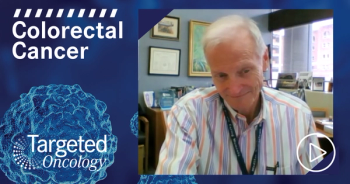
Diagnosis of Metastatic Colorectal Cancer
Edward Chu, MD:This is a fairly young patient51 years of age—who presents what was deemed to be initially surgically unresectable liver-limited metastatic colorectal cancer. Genetic testing found that the patient’s tumor had a mutation in theKRASgene, specifically aG12Dmutationwhich is one of the most common mutations observed in theKRASgeneand mutational analysis of theBRAFgene did not identify any mutations. Except for some upper GI reflux, which is pretty common in this age group, the patient has no other comorbid illnesses. The patient has absolutely no tumor-related symptoms, and thus she was deemed to have a PS of 0. It is quite appropriate for this patient to be initially treated with FOLFOX chemotherapy in combination with the anti-VEGF antibody, bevacizumab.
We now know that mutational analysis of a patient’s tumor is critically important, as it helps us to identify what kinds of therapies should be selected for an individual patient. Specifically, we know that extendedRAStesting will tell us whether or not a patient should be treated with an anti-EGFR antibody therapy, whether it be cetuximab or panitumumab, and to be used in combination with cytotoxic chemotherapy. In addition, we also now know thatBRAFtesting is also very important because, again, the data would tell us that in patients whose tumors harborBRAFmutations, they generally are not responsive to anti-EGFR antibody therapy.
It’s interesting that over the last couple of years, we now have a much better appreciation of the importance of the location of the primary tumor. Alan Venook, 2 years ago at the ASCO plenary session, provided a very interesting presentation showing that the sidedness of the primary tumor not only served as a prognostic indicator but also could predict what type of therapy a patient should receive. When we now look back at the literature dating back to 20, even maybe 30, years ago, there are data showing that the sidedness of the primary tumor impacts either the progression-free survival or the overall survival of patients with metastatic colorectal cancer. And there are now probably 4 to 5 other randomized clinical trials that I think provide further support for the importance of sidedness as a prognostic indicator but also as a predictive marker.
So based on all of the clinical data that have been presented or published to date, I think the data are pretty clear that in patients whose primary tumors come from the right side of the colon, those patients have a significantly worse prognosis than those patients whose primary tumors come from the left side of the colon. And in addition, as it relates to the sidedness serving as a predictive marker, it appears that in those primary tumors that come from the right side of the colon, those patients do not derive benefit from therapy with an anti-EGFR antibody, whether it be cetuximab or panitumumab. In contrast, in patients whose tumors come from the left side of the colon, those patients derive significant benefit from either cetuximab or panitumumab. Interestingly, while bevacizumab is active in patients whose tumors come from either the right or left side of the colon, their benefit seems to be also greater when the primary tumor comes from the left side of the colon.
It has always been curious why there is this difference between right- and left-sidedness. And in part, it may stem from the fact that the left side of the colon and the right side of the colon come from different embryologic parts. So, for instance, the right side of the colon comes from the mid-gut, whereas the left side of the colon comes from the hind gut. Molecular-based studies also now show that there are clearly molecular differences and biologic differences in tumors that come from the left side versus the right side of the colon. So, in fact, it probably has more to do with biology than just geographical location.
Transcript edited for clarity.
December 2014
- A 51-year old Caucasian female presented with severe crampy right lower quadrant pain
- She had a 4-month history of occult bleeding, and significant weight loss of over 10 pounds in the last 8 months
- She sought medical treatment after experiencing severe cramping in the abdomen and bloody diarrhea
- Past medical history included GERD, managed with a proton pump inhibitor and appendectomy at age 35
- Laboratory evaluation showed grade 2 anemia (hemoglobin 8.7 g/dL) and carcinoembryonic antigen (CEA) level of 4.5 ng/mL
- Colonoscopy revealed an obstructive lesion in the ascending colon, measuring approximately 15 cm
- Pathological findings showed invasive and poorly differentiated adenocarcinoma with ulcer
- 10 of 15 lymph nodes sampled were positive for tumor
- CT scan revealed widespread lesions in both lobes of the liver, and she was diagnosed with stage IV disease
- Mutation testing; KRAS-positive (G12D) and BRAF-negative
- Her ECOG performance status was 0
- She was treated with six cycles of FOLFOX + bevacizumab, and appeared to be responding well to treatment; follow-up imaging showed reduction in the size of the liver lesions
November 2015
- Follow-up CT showed progression in the liver with new lesions and new small masses in the abdomen and pelvis
- Her ECOG performance status was 1
- She began therapy with FOLFIRI + bevacizumab
December 2015
- The patient complained of severe fatigue
- CT scan revealed progressive disease with no improvement in the size and number of the abdominal lesions and the presence of 3 pulmonary nodules in the right lung
- She was then switched to trifluridine/tipiracil (TAS-102)
- PET/CT at 3 months and 6 months showed stable disease
- Her ECOG performance status improved (PS 0)








































